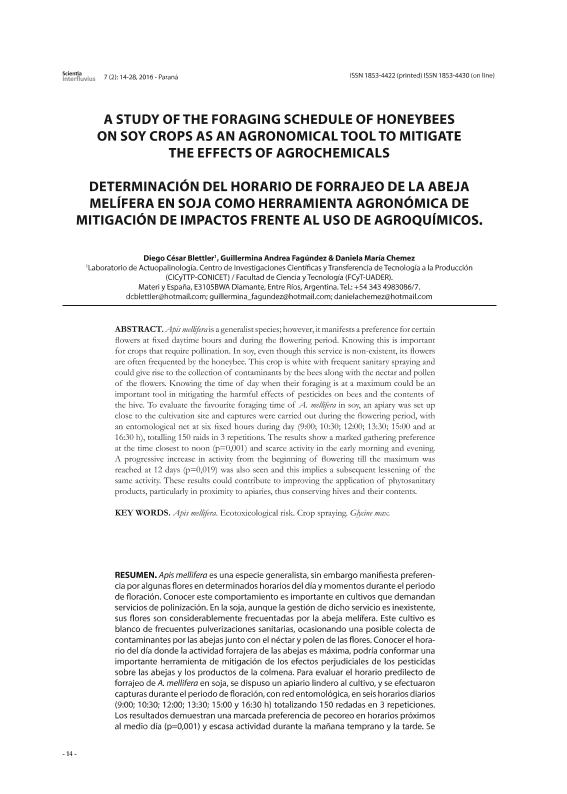Artículo
A study of the foraging schedule of honeybees on soy crops as an agronomical tool to mitigate the effects of agrochemicals
Título:
Determinación del Horario de forrajeo de la abeja melífera en soja como herramienta agronómica de mitigación de impactos frente al uso de agroquímicos
Fecha de publicación:
12/2016
Editorial:
Universidad Autónoma de Entre Ríos
Revista:
Scientia Interfluvius
ISSN:
1853-4422
e-ISSN:
1853-4430
Idioma:
Inglés
Tipo de recurso:
Artículo publicado
Clasificación temática:
Resumen
Apis mellifera is a generalist species; however, it manifests a preference for certain flowers at fixed daytime hours and during the flowering period. Knowing this is important for crops that require pollination. In soy, even though this service is non-existent, its flowers are often frequented by the honeybee. This crop is white with frequent sanitary spraying and could give rise to the collection of contaminants by the bees along with the nectar and pollen of the flowers. Knowing the time of day when their foraging is at a maximum could be an important tool in mitigating the harmful effects of pesticides on bees and the contents of the hive. To evaluate the favourite foraging time of A. mellifera in soy, an apiary was set up close to the cultivation site and captures were carried out during the flowering period, with an entomological net at six fixed hours during day (9:00; 10:30; 12:00; 13:30; 15:00 y 16:30 h), totalling 150 raids in 3 repetitions. The results show a marked gathering preference at the time closest to noon (p=0,001) and scarce activity in the early morning and evening. A progressive increase in activity from the beginning of flowering till the maximum was reached at 12 days (p=0,019) was also seen and this implies a subsequent lessening of the same activity. These results could contribute to improving the application of phytosanitary products, particularly in proximity to apiaries, thus conserving hives and their contents.
Palabras clave:
Apis Mellifera
,
Ecotoxicological Risk
,
Crop Spraying
,
Glycine Max
Archivos asociados
Licencia
Identificadores
Colecciones
Articulos(CICYTTP)
Articulos de CENTRO DE INV.CIENT.Y TRANSFERENCIA TEC A LA PROD
Articulos de CENTRO DE INV.CIENT.Y TRANSFERENCIA TEC A LA PROD
Citación
Blettler, Diego César; Fagundez, Guillermina Andrea; Chemez, Daniela María; A study of the foraging schedule of honeybees on soy crops as an agronomical tool to mitigate the effects of agrochemicals; Universidad Autónoma de Entre Ríos; Scientia Interfluvius; 7; 2; 12-2016; 14-28
Compartir




